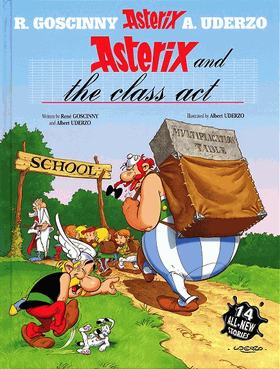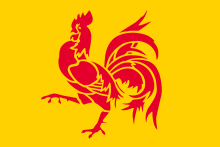
Gaul was a region of Western Europe first clearly described by the Romans, encompassing present-day France, Belgium, Luxembourg, and parts of Switzerland, the Netherlands, Germany, and Northern Italy. It covered an area of 494,000 km2 (191,000 sq mi). According to Julius Caesar, who took control of the region on behalf of the Roman Republic, Gaul was divided into three parts: Gallia Celtica, Belgica, and Aquitania.

Wallonia, officially the Walloon Region, is one of the three regions of Belgium—along with Flanders and Brussels. Covering the southern portion of the country, Wallonia is primarily French-speaking. It accounts for 55% of Belgium's territory, but only a third of its population. The Walloon Region and the French Community of Belgium, which is the political entity responsible for matters related mainly to culture and education, are independent concepts, because the French Community of Belgium encompasses both Wallonia and the bilingual Brussels-Capital Region but not the German-speaking Community of Belgium.

Silbannacus was an obscure Roman emperor or usurper during the Crisis of the Third Century. Silbannacus is not mentioned in any contemporary documents and his existence was forgotten until the 20th century, when two coins bearing his name were discovered, the first in the 1930s and the second in the 1980s. His unusual name suggests that he might have been of Gallic descent.

Asterix and the Class Act is officially the thirty-second album of the Asterix comic book series, by René Goscinny (stories) and Albert Uderzo, published in 2003. Unlike the other Asterix books, it is a compilation of short stories, rather than one long story. Each story has an introductory page giving some of its original history.
The name France comes from Latin Francia.

Alesia was the capital of the Mandubii, one of the Gallic tribes allied with the Aedui. The Celtic oppidum was conquered by Julius Caesar during the Gallic Wars and afterwards became a Gallo-Roman town. Modern understanding of its location was controversial for a long time; however, it is now thought to have been located on Mont-Auxois, near Alise-Sainte-Reine in Burgundy, France.

Alise-Sainte-Reine is a commune in the Côte-d'Or department in the Bourgogne-Franche-Comté region of eastern France.

Adidas Tricolore was the official match ball of 1998 FIFA World Cup in France. The Tricolore was officially unveiled in December 1997, being the first colorized ball used in a FIFA World Cup.

The Bekisar, or Ayam Bekisar, is the first-generation hybrid offspring of the green junglefowl and domesticated red junglefowl from Java. The roosters have a glossy blackish-green plumage and are highly prized for their loud clear calls and striking colouration, while the hens are usually dull and infertile.

Chickens have been widely used as national symbols, and as mascots for clubs, businesses, and other associations.

The Rassemblement Wallonie France is a small political party in Belgium. It is active in Wallonia and the Brussels-Capital Region. In Brussels it is known as the Rassemblement Bruxelles France or RBF. Its aim is the secession of Wallonia, Brussels and the six Flemish municipalities with language facilities for French-speakers around Brussels from Belgium and to unite them with France.

The flag of Wallonia represents the Walloon Region and the French Community of Belgium. Designed in 1913, the flag depicts a red rooster on a yellow field. The rooster represents Walloon adherence to French culture as well as their Gallo-Roman origins. The red and yellow coloring is historically associated with the city of Liège. The flag's association with Wallonia also mean that it is commonly used by the Walloon Movement.
The Helvii were a relatively small Celtic polity west of the Rhône river on the northern border of Gallia Narbonensis. Their territory was roughly equivalent to the Vivarais, in the modern French department of Ardèche. Alba Helviorum was their capital, possibly the Alba Augusta mentioned by Ptolemy, and usually identified with modern-day Alba-la-Romaine. In the 5th century the capital seems to have been moved to Viviers.

Chantecler is a verse play in four acts written by Edmond Rostand. The play is notable in that all the characters are farmyard animals including the main protagonist, a chanticleer, or rooster. The play centers on the theme of idealism and spiritual sincerity, as contrasted with cynicism and artificiality. Much of the play satirizes modernist artistic doctrines from Rostand's romanticist perspective.

Ayam Brand is a multinational food company, specialising in prepared foods, including seafood, canned fish and canned vegetables, especially baked beans. Ayam's product offerings vary by country. The sole owner of Ayam Brand is a company called Ayam S.A.R.L.

National symbols of France are emblems of the French Republic and French people, and they are the cornerstone of the nation's republican tradition.

Founding of the Nation is a 1929 oil painting by Japanese yōga artist Kawamura Kiyoo (1854–1932). Based on the myth of the cave of the sun goddess from the Kojiki, the painting resides at the Musée Guimet in Paris, where it is known as Le coq blanc or The white cockerel.

The St. Nicholas Cathedral also called St. Nicholas of Bari Cathedral is the cathedral of the Roman Catholic Diocese of Đà Lạt, suffragan of the Archdiocese of Ho Chi Minh City, located in Da Lat, the capital of Lam Dong province in the Central Highlands of Vietnam.

There are numerous cultural references to chickens in myth, folklore, religion, and literature. Chickens are a sacred animal in many cultures, being deeply embedded in belief systems and religious worship practices.




















